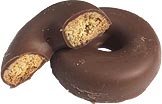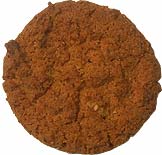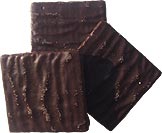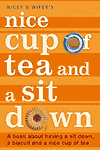Crawfords chocolate rings | | Monday 5 May 2003 |

 | Now as we all know the mighty United Biscuits has been having a bit of a sorting out of its brands, with the McV sub brand being the trendy alter ego to the dependable McVities. Crawfords, very much the B team, is actually the oldest brand in the portfolio, going back to a 19th century Scottish family bakers run by William Crawford in Leith Edinburgh. To bring back a bit of tradition and heritage to the UB stable Crawfords has received a bit of a face lift. Gone are the two tone purple wrappers that so distinctively graced many a corner shop or petrol station biscuit selection to be replaced with a large red device looking rather like a horizontally elongated fairy cake bearing the name Crawfords two crossed ears of something and the legend "Baking family biscuits since 1813". So its a bit of a pity that this weeks brand new offering from Crawfords were baked in Spain.
So what do we have here? Well we have reviewed both the white chocolate and the milk chocolate packs. Now both rings have very much the air of something you would find in Christmas selection tin, and are a bit of a departure from the traditional biscuits we are used to from Crawfords. The biscuits themselves are pleasant enough. The chocolate coat is not overdone and their small size means that you are going to probably pop them in your mouth whole. However they are also a bit forgettable just like that nameless chocolate coated shape in the Christmas tin. I would see these playing quite an important role in the plates of biscuits you get given at hotels that offer conference facilities and want to create a slight air of opulence.
So what's going on with the family bakers getting biscuits from Spain? Well UB are a big operation and its got a whole bunch of bakeries in Spain. So in one pack we get both extremes an invocation of tradition and a demonstration of a pan-european conglomerate. However, this does appear to be a interesting new direction for the UB biscuit machine, and its going to worth keeping an eye on. Your feedback 1 message |
| ANZAC biscuit | | Friday 25 Apr 2003 |
 | We couldn't miss the opportunity to review ANZAC biscuits on the 25th April, ANZAC day. Dating back to 1915 the ANZAC biscuit is the stuff of national pride and tradition for both Australians and New Zealanders, whose forefathers ate them in the trenches during the Gallipoli campaign of WW1.
Now its a bit of a tricky beast to pin down. There are several explanations for how the biscuit came to be, from soldiers making simple biscuits from their rations in the trenches, to a sort of military specification super hard biscuit able to withstand global trips, to housewives back in Oz and NZ making them as part of the war effort. I suspect that all explanations are true, and certainly account for the differing types of ANZAC biscuit. The military one was a square of hard unyielding floury stuff, with either 9 or 15 holes depending on who you believe. The second sort was much more the sort of thing you would want to find in a parcel from overseas, and is the type we are reviewing here.
Unibic bake their ANZACs in Reservoir Victoria, Australia, and proudly display that for each pack sold they donate 6c to Australian veterans. The more popular ANZAC recipe includes flour, oats and desiccated coconut in equal proportions as well as butter sugar and golden syrup. This results in a wholesome and high roughage biscuit which many Australians insist have toe nail clippings and the like in, although it seems both unlikely and futile to attempt increase its fibre content. Unibic seem to have tinkered a little bit with tradition to make their ANZAC a bit sweeter than those baked in war time, and probably a bit less abrasive. Also the coconut doesn't intrude as it so easily can. The pack has stirring stuff on it like "Even today we should never lose sight of the purpose of these biscuits, because we should never lose sight of the real meaning of ANZAC".
We have greatly enjoyed tucking into our ANZACs this week, they certainly hark back to a simpler age of biscuit eating, and definitely taste home baked. We just wish that the in-fighting amongst the Aussies and Kiwis about who really invented the ANZAC and who really makes the proper ones will not be directed our way after this review. In the interests of fairness friends who have recently returned from a trip to NZ told us that particularly liked the ANZAC biscuits they ate there.
Thanks to Simon Smith for shipping the ANZACs to us.
Your feedback 2 messages |
| Bahlsen Afrika | | Tuesday 22 Apr 2003 |
 | Bahlsen are perhaps best known in the UK for their Choco Liebniz, a refined chocolate slab with a biscuit stuck in it. Bahlsen who were founded in Hannover, Germany in 1891, now have biscuit bakeries in several European countries but none in in the UK. As such the whole Bahlsen range is distinctively continental, which is to say it makes perhaps the most sense when viewed from over the brim of a coffee cup rather than a tea cup.
This weeks biscuit is certainly one of those aimed at a coffee drinkers. Afrikas are small square wafers entirely covered in Dark Chocolate, very dark chocolate. In fact I was forced to blow the dust of the coffee pot as I'm known to do once in a while. Maybe it was coincidence , but I actually sneezed a couple of times as I ate the first few Afrikas. Could the chocolate have been that strong? Possibly. The small sized of the Afrika (35mm x 35mm x 3mm), meant that we took the unusual step of taking a group picture.
Now we could possibly be impressed by Bahlsen claims to have the 'most advanced and largest wafer production plant in Europe' in the Barsinghausen, Germany factory (Operational 1982). We would be impressed only its wafers, which aren't anything to be impressed by.
The name is a little iffy, a wonky spelling of Africa. Is this the German spelling? I couldn't help but have Toto's nasty eighties hit 'Africa' playing in my head, sure as Kilimanjaro rises like Olympus above the Serengeti, I regret to say.
Still we would see the Afrika confidently taking a central role in the plate of after dinner biscuits. Your feedback 2 messages |
| |
|
|







